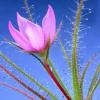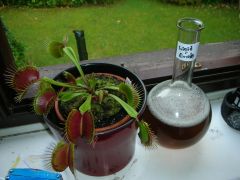
ewjlamb
Full Members-
Posts
82 -
Joined
-
Last visited
-
Days Won
2
ewjlamb last won the day on December 5 2020
ewjlamb had the most liked content!
Profile Information
-
Location
East Anglia - Peterborough
-
Interests
Raising seed, gym, music.
ewjlamb's Achievements
9
Reputation
-
Please, what was this about ?
-
COIR experiment on lockdown
ewjlamb replied to Poppy's topic in Sustainable and Peat-free Cultivation
Cool. Thanks for sharing your experiements with us. A few years back, I was trialling a similar peat-free pathway and my initial tests were all with native Drosera seedlings on the allotment. Originally I loved coir, because of the action and convenience, and the fact I could buy it from the pound store. After two seasons I purchased a pallet load of reclaimed peat, as harvested from resevoir bottoms (marketed as Moorland Gold). I was not 'in' on RO or TDS measuring devices back then ! Some time after that, I read with great interest on this forum about a grower who uses pure grit for all thier CP's, and tried this with some plants too. Also, I tested a bonsai medium like reddish grit, on a semi-mature seedling Darlingtonia. They grew OK. After reading the Australian botanist Allen Lowrie, about CP substrate and particle size (personal correspondence, 2013) and further experiments; I became convinced that you can grow most 'truly terrestrial' CPs in pure grit, but only if the particle sizes exhibit both great variation and random distribution volumetrically. Excluding perhaps the terrestrial butterworts. -
Yes, the same thing is happening to my P. grandiflora, which are 2nd-year seedlings. In fact, I have had then on a East-Southeast windowsill with some Mexican Pings, because I didn't have time to make an anti-pigeon screen earlier in the season. (Problems/ concerns with a mitre saw and making circles). I am contemplating, whether to just leave them alone (option 1) or alternatively, to try artificially wintering them in the refrigerator and so going for a double growing season(option 2) . But, owing to known daylength and light frequency sensitivity in plants generally, it may be necessary to keep the hibernaculae, once full-developed, in the 'fridge till next spring (option 3).
-
Yes. Good work. Especially weeding out the seedlings, keep that up !
-
Hi ! I've experienced similar occurrences before, although do not currently grow any drosera. In particular I had a wonderful plant, either a turbo-charged Drosera intermedia or a fluke hybrid, that grew larger from its hibernacula each year until resembling a splendid, geometrical 'pincushion'. The petioles were deep red in high season, as yours may well be. However, perhaps I can help a little.... There is a hybrid of DD rotundifolia and intermedia, this is called Drosera x obovata. Also, there is a hybrid of DD rotundifolia and anglica, and this is D. x beleziana. There are also forms of Drosera intermedia I believe, that grow bigger and more impressive than the 'average' or type. It is my belief that sundew hybrids are not fertile, although not 100% certain of this. There are different sections within Drosera, such that 'random' hybrids say, between south African and northern hemisphere / temperate species do not occur. Perhaps the first test will be to see if you set fertile seed from this cultivar? Please keep us posted !
-
Dear CP growers, I am delighted to report some success in the cultivation of P. grandiflora. Please take some time to review the picture below. In 2012, I received seed and experienced a good rate of germination. Spurred on by the 'buttery', I purchased what must surely be a piece of fake tufa from the local aquarium specialist. It's a kind of chalk or Normandy stone that's been subject to water erosion. Pitted and knobbly, in short ideal material to stuff with a peat/clay mix and to semi-submerge in a bowl of rainwater. A few years later, and the seedlings have been transplanted into the moss. In 2015 or 2016 they flowered, and again this year too. What I like about this, is that here you have a stable and showable method of cultivating your hardy pings!!!
-
Oh that's interesting. Great stuff! Thanks L8rs!
-
Good afternoon esteemed CP-ers, I am writing this post to reach out to experienced growers anywhere with the following question:- "Does Drosera binata 'T form' actually exist?" I've been intermittently tending a mixed collection of CPs for many years, and try as I might, I've not yet succeeded in growing a form of binata that branches once and once only. OK, so my maintenance and repotting routines are not the best in the world and granted, the D. binata and its variants are lusty, vigourous and self-fertile so that it's likely I've often been supplanted in a given pot by mongrel offspring. Nonetheless, on occasions I've sought this and an old, faded plant label among my plants confirms the notion. If the 'T Form' does indeed exist , could anyone please confirm whether it comes true from seed. With thanks, Jonathan
-
Hi! I think too that's great! People will especially appreciate live sphagnum in 'polarized' bundles. I mean, with the tips at the top. Way back I went to a collectors' open day in Norwich and bought some live sphagnum from the grower. We harvested it carefully from his cultivated plants and I never looked back. Incidentally, are you making a grow-list of the mosses you have discovered on your land? This would be a great WWOOFing opportunity for the right person!!!
-
I have come across this charming volume in Project Gutenburg's online e-Book library: G. F. Scott Elliot - The Romance of Plant Life. Link: http://www.gutenberg.org/files/45930/45930-h/45930-h.htm#Page_201 There are very interesting descriptions of succession, development of peat bogs, and many references to carnivorous plants throughout - although primarily a work on the subject of 'ethnobotany' one would imagine, rather than botany, horticulture or ethnography. It really repaid a few hours' study!
-
Cool!
-
Yup I tend to agree with N Lowii. It looks like a combination of stressor environmental factors as well as possible insect damage at least on one of your S. purpurea hybrids. But hey some of those pics show magnificent success for all your very hard work. If you can spot tiny insects such as aphids lurking on young pitchers/phyllodes or in the rhizome; you could always try the old trick of a cotton wool soaked in meths. But despite what the books tell you, many CP's are not happy in your average room in a house and would be far better being left to their own devices outside . We try so hard to get our plants through freak weather seasons, or to give enough light intensity or whatever, but in my experience freshness is vital as is finding some kind of 'Tao' in one's cultivation efforts. I think that Feng Shui can be quite a useful way of approximating these things and also bear in mind that houses have very unnatural airflow mostly; and also that the micro-ecosystem in a particular plant pot can take a year on upwards to 'stabilise' in some cases if not others. Like myself, I think you probably err on the side of trying too hard - no discouragement or disrespect - and instead of trying to avoid getting things wrong why not just establish the basics, and observe disinterestedly what happens. My plants never grew so beautifully as when they were almost quite out of reach a few villages away!!! Good luck
-
Carnivorous plants at Madagascar
ewjlamb replied to johnvdw's topic in Carnivorous Plants in Habitat
What a great trip! Thanks.












